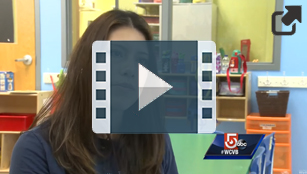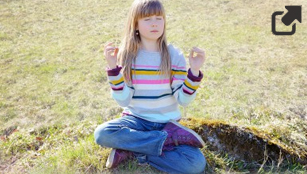- Explore how to involve coworkers in stress-reduction activities.
- Examine how to incorporate practices into your work with children.
- Identify benefits associated with gratitude.
Learn
Know
Take a moment to think about a time when you were trying to learn a new skill as part of a group--it could have been a study group, a small discussion group in a workshop, or a class on quilting. Think about how it helped to have people around you who were working toward the same goal, who were understanding and supportive of your own efforts.
As the use of stress-reduction strategies by individuals has increased, researchers have explored the benefits of using these evidence-based approaches with groups, particularly with groups of professionals whose work environments can be stressful, such as nurses and teachers. Positive benefits have been shown to occur when mindfulness and other stress-reducing techniques are embraced as part of the workplace culture. Not unlike when we engage a partner to exercise with, as a way to help us change our habits in support of our health, having others around you who also practice stress reduction and resilience-building strategies can be helpful in your efforts to attend to your own social-emotional health.
One of the added benefits of having these practices used by those around you is that you increase the chances that your daily interactions are with calmer, more relaxed colleagues and children. Another benefit for the children in your care is that research conducted on mindfulness programs in K-12 schools has found these programs can improve children's attention, learning, and responses to stress.
Another practice that helps build our own resilience and can build the resilience of those we work with is to become intentional about being thankful and expressing gratitude. Gratitude has been the subject of much recent research with both children and adults, and it has been shown to have benefits related to both psychological and physical functioning. It not only helps boost the well-being of the person or group receiving the gratitude, the act of identifying what you are grateful for and specifically expressing to others what you appreciate helps the giver's well-being, too. Moreover, gratitude strengthens relationships, a key factor in social competence and social-emotional functioning. Take a moment and think back on your life. Is there a person who has supported or influenced you in some way? Who is this person (maybe a family member, friend, former or current colleague, coach, children or their parents)? How did this person affect you for the better? Did you have an opportunity to thank and express gratitude to this person? Now imagine that you came face-to-face with this person. What would you say? How would you describe your emotion and the physical reaction that accompanied your feelings?
Making a conscious effort to remind yourself to be grateful for both little things and big ones can change your mood, emotions, reactions to stressors, and physical health. Expressing gratitude to others creates a positive social experience and strengthens bonds between people. When you feel disappointed, irritated, angry, or stressed, take a moment to practice relaxed breathing and recall a moment or a person that made you feel grateful. Switching your attention from the stressful event to the grateful experience will change your feelings and thoughts. Practice this simple strategy day-to-day. It has the potential to strengthen your relationships with others and impart physical and psychological benefits to you directly.
In Lesson Three, you learned that the brain's natural inclination toward negativity, although important to survival, may be responsible for negative emotions and behaviors in your interactions with others. Although it is adaptive to analyze "bad events" so that they can be avoided in the future, too much time spent on the negative is not beneficial to our resilience. Expressing gratitude is a conscious strategy for overcoming the brain's negativity bias and for bolstering resilience and increasing feelings of wellness in you and in the recipients of your kindness. As with other resilience strategies, we can learn to cultivate and express gratitude. And, just like with other strategies we have explored, gratitude can be adopted as part of a workplace culture. Particularly in early-childhood settings, being surrounded by adults who model generosity, thankfulness, and gratitude enhances children's social-emotional development.
See
When you involve children in self-care practices, you are helping them build strategies to identify their own feelings and attend to them in socially productive ways. Watch the video below to see how one preschool teacher incorporated a breathing exercise in her classroom practices. What do you notice about the children's responses? How do you think incorporating this with your children and colleagues could help you and others in your program?
In addition to teaching children controlled or "belly" breathing, you can add physical movements to the breathing, such as yoga poses, that will help reduce children's anxious feelings. Using objects or animals to name the movements and poses allows you to keep it playful for the children. The link below provides some ideas on how to incorporate yoga into children's activities.
Do
Below are some suggestions on how to extend the strategies you have learned in this course to activities with your coworkers or with the children in your classroom. Use them as a place to start in cultivating a culture that encourages well-being for everyone.
- Ask other teachers and caregivers in your center to explore the SELF-T course or a lesson from it that you particularly liked. If they find it helpful, suggest that in your section--or even just in your classroom with your co-teacher or assistant-you begin your day by practicing a one-minute breathing or imagery exercise together.
- Talk with your fellow teachers and caregivers about the importance of reducing stress and share the Explore activity from Lesson One. Brainstorm ways you can incorporate the strategies into your work. For example, agree to offer support for each other when there are signs of stress, and agree to ask for support when things feel overwhelming. Learn to remind each other to breathe. Strategize on ways to reduce your stress through the techniques you have learned.
- Lead the children in your care in a breathing exercise. Keep it short, positive, and adapted for their age. Think about incorporating it as a regular part of your circle time. Even with very young children, you can gather them together and model taking deep breaths. Talk with them about people and things that make them happy. You could also engage preschoolers or older children in practicing some stretching or beginner yoga movements, or even in some guided imagery experiences. See this resource as one example of how you could engage young children in guided imagery: http://www.healthpoweredkids.org/lessons/guided-imagery-for-younger-children/. See this short clip from Child Trends about mindfulness in a school setting: https://youtu.be/2ChEnJdE0FU.
- Create areas of your classroom or program that help support self-care. Try creating spaces where children, or fellow staff members, can listen to soothing music or a guided breathing exercise. Offer a quiet, calming space, perhaps with tools to help label emotions, identify thinking traps, and dispute negative beliefs. You could print off and include some of the resources provided in this course, or for children, try using some of the resources available in the Positive Guidance, Social & Emotional Development, and Learning Environments courses.
- Work with children on labeling emotions, and as discussed in Lesson Three, modeling how to challenge the negative beliefs in sensitive, developmentally appropriate ways. The language and perspective you offer can go a long way in promoting resilience in your care setting.
- Review 5 fun ways to bring mindfulness to children such as, balloon breath, starfish breathing, calming glitter bottle, five senses, and pleasure gazing on pages 52-58 of this resource: https://www.zerotothree.org/document/1262
- Write a gratitude note to someone you work with or a parent whose child is in your class. Note a kindness, a helping hand, or a word of support they have given you. Explain the importance of this gift to you. Be concrete in describing the behavior and the impact.
- Lead the children in your class or program in a gratitude activity. Ask children to share what they are thankful for during a circle time or a small group meeting. Model expressing descriptive and sincere thanks for others--fellow staff and children. Engage children in literacy or creative expression experiences around thankfulness; you could encourage them to construct letters or pictures to express their gratitude to family members, community helpers, or other key staff in your building (e.g., the cook for the delicious snack that day). Take time to talk with children about thankfulness as they draw a picture or make an item to show their gratitude.
Explore
Follow the link to a short article published in Critical Care Nurse that summarizes the research on the benefits of gratitude. Share a few of the things you learned with your colleagues or those important to you in your life. Then, use the Gratitude Stone Activity for an exercise you can do alone or with a group to create a visual prompt for grateful thoughts.
Apply
The acronym for title of this course, SELF-T for Social Emotional Learning for Teachers, is also a good acronym for an approach that can serve you well when you face stressful situations, including those you might encounter in your classroom. Use the SELF-T Approach for Teachers resource below and post it where it will remind you to practice the stress-reducing, resilience-building techniques you have learned.
This course has introduced many strategies to identify and manage stress and promote healthy well-being. Below we offer two practice inventories, one aimed at direct care staff, and one aimed at Program Managers and/or Training & Curriculum Specialists. Use the practice inventory that is specific to your role, to reflect more deeply about the practices that you use to manage stress, promote self-care and support healthy well-being.
Glossary
Demonstrate
Child Trends. (2019). Mindfulness in schools. Retrieved from https://www.childtrends.org/videos/mindfulness-in-schools
Emmons, R. (2013). Gratitude Works: A 21-day Program for Creating Emotional Prosperity. San Fransico, CA: Jossey-Bass.
Frederickson, B. L. (2009). Positivity. New York, NY: Crown Publishers.
Gehl, M., & Hackbert, L. (2019). Getting started with mindfulness: A toolkit for early childhood organizations. ZERO TO THREE. https://www.zerotothree.org/document/1262 and https://www.zerotothree.org/resources/2896-getting-started-with-mindfulness-a-toolkit-for-early-childhood-organizations
Hagen, I., & Nayar, U. S. (2014). Yoga for Children and Young People's Mental Health and Well-Being: Research review and reflections on the mental health potentials of yoga. Frontiers in Psychiatry, 5, 35. doi.org/10.3389/fpsyt.2014.00035.
Hanson, R. (2009). Buddha's Brain: The practical neuroscience of happiness, love and wisdom. Oakland, CA.: New Harbinger Publications, Inc.
Jayawardene, W. P., Lohrmann, D. K., Erbe, R. G., & Torabi, M. R. (2017). Effects of Preventive Online Mindfulness Interventions on Stress and Mindfulness: A meta-analysis of randomized controlled trials. Preventive Medicine Reports, 5, 150-159. doi.org/10.1016/j.pmedr.2016.11.013.
Maclellan, E. (2017). Live, laugh, learn: striking a balance in life is important to this sharply focused entrepreneur and fun-loving laughter yoga teacher. Ohio State Alumni Magazine. Retrieved from https://www.osu.edu/alumni/news/ohio-state-alumni-magazine/issues/winter-2017/laughter-yoga.html
Mendelson, T., Greenberg, M.T., Dariotis, J.K. et al. (2010). Feasibility and preliminary outcomes of a school-based mindfulness intervention for urban youth. J Abnorm Child Psychol 38(7), 985-994. https://doi.org/10.1007/s10802-010-9418-x
Merrill, S. (2020, September 11). Trauma is 'written into Our Bodies'-but educators can help. Edutopia. https://www.edutopia.org/article/trauma-written-our-bodies-educators-can-help
Nansook, P., Peterson, C., & Seligman, M. (2004). Strengths of Character and Well-Being. Journal of Clinical and Social Psychology, 23(5), 603-619.
The National Academies of Sciences, Engineering and Medicine. (2022). Tools for supporting emotional wellbeing in children and youth. https://nap.nationalacademies.org/resource/other/dbasse/wellbeing-tools/interactive/index.html
Seligman, M. (2002). Authentic Happiness: Using the new positive psychology to realize your potential for lasting fulfillment. New York: The Free Press.
Seligman, M. (2012) Flourish: A visionary new understanding of happiness and well-being. New York: The Free Press.
Van Daele, T., Van Audenhove, C., Vansteenwegen, D., Hermans, D., & Van den Bergh, O. (2013). Effectiveness of a Six Session Stress Reduction Program for Groups. Mental Health & Prevention, 1(1), 19-25.
Zenner, C., Herrnleben-Kurz, S., & Walach, H. (2014). Mindfulness-Based Interventions in Schools-A systematic review and meta-analysis. Frontiers in Psychology, 5, 603. http://doi.org/10.3389/fpsyg.2014.00603.




